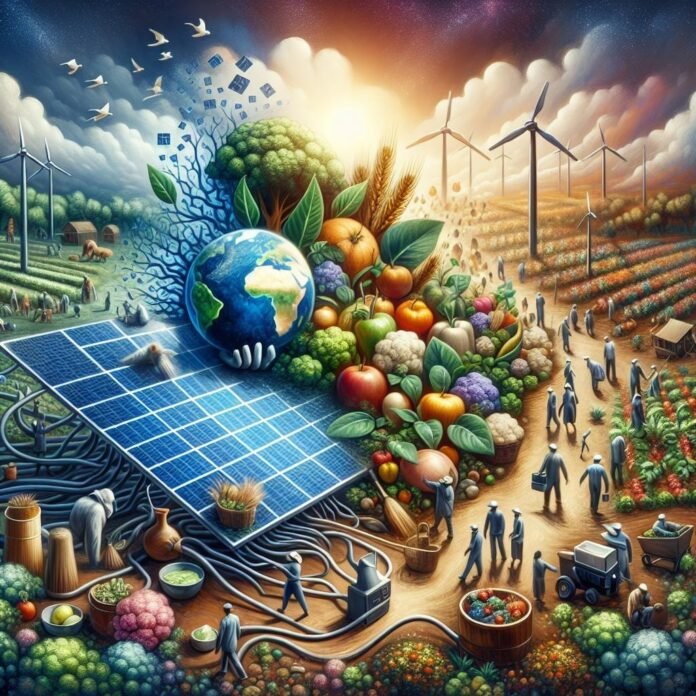As the world grapples with the dual challenges of climate change and food security, innovative solutions in agriculture are more crucial than ever. among the most promising developments is the rise of off-grid solar energy—a game-changer that offers a sustainable and reliable power source for farmers, particularly in remote and underserved areas. This technology not only enhances productivity and efficiency but also empowers communities by enabling them to take control of their energy resources. In this article, we will explore how off-grid solar systems are revolutionizing food production, driving resilience in agricultural practices, and paving the way for a more sustainable and self-sufficient future for farmers around the globe. Join us as we delve into the transformative impact of solar energy on the agricultural landscape and highlight inspiring success stories that illustrate the potential of this eco-friendly approach to farming.
Table of Contents
- Harnessing Solar Power for Sustainable Farming Practices
- Improving crop Yields and Reducing Costs with Off-Grid Solutions
- Enhancing Food Security through solar-Driven Irrigation Systems
- Incorporating Renewable Energy in Agricultural Policies and education
- to sum up
Harnessing Solar Power for Sustainable Farming Practices
The integration of solar power into farming practices represents a revolutionary shift towards a more sustainable agricultural model.As farmers face increasing pressure from climate change and resource scarcity, adopting off-grid solar solutions paves the way for a greener future. By harnessing solar energy, farmers can significantly reduce their reliance on fossil fuels and lower operational costs. This approach not only enhances energy independence, but it also contributes to reducing greenhouse gas emissions, creating a more resilient agricultural system.
With solar technology, farming operations can include a range of applications that contribute to overall efficiency and productivity. Some notable uses of solar power in agriculture include:
- irrigation systems: Solar-powered pumps can facilitate efficient water management.
- Crop monitoring: Utilizing drones and sensors powered by solar energy to optimize field management.
- Cooling systems: Solar refrigeration for storing produce, ensuring freshness and reducing waste.
Considerable potential lies in the synergy between solar power and technology, as farmers increasingly adopt these innovations to enhance their sustainable practices. A closer look at energy consumption and savings shows how solar energy can revolutionize farming.
| Off-Grid Solar Applications | benefits |
|---|---|
| Solar Irrigation | Efficient water usage |
| Solar-Powered Sensors | Real-time data for better decisions |
| Solar Refrigeration | Preservation of harvests |
Improving Crop Yields and Reducing Costs with Off-Grid Solutions
Farmers are increasingly turning to off-grid solar solutions as a means of enhancing productivity and decreasing operational costs. By harnessing the power of the sun, thay can power essential agricultural equipment such as irrigation systems, refrigeration units, and even machinery without the constraints of unreliable grid electricity. This leads to a significant reduction in energy expenses, allowing farmers to reinvest savings back into their operations. additionally, off-grid solar systems are often modular, enabling farms to expand their energy capacity as their needs grow, ensuring a sustainable approach to agricultural progress.
Moreover, the ability to produce energy on-site lessens dependency on fossil fuels, positively impacting both the surroundings and farmers’ bottom lines. One of the key advantages of off-grid solar is its reliability, especially in remote areas where traditional electricity services may be unreachable.This reliability translates directly to enhanced crop management and the capability to schedule activities according to optimal conditions. The following factors illustrate how off-grid solutions contribute to better crop yields:
- Reduced energy costs: Lower operational expenses on powering equipment.
- Enhanced irrigation control: Ensuring crops recieve consistent water supply.
- Efficient storage: Better management of perishable goods through solar-powered refrigeration.
- Increased access to information: empowering farmers with technology for better decision-making.
| Benefit | Impact on Crop Yields |
|---|---|
| Consistent Irrigation | Higher water efficiency leads to improved growth. |
| Energy Independence | Enables timely operation of farming tasks. |
| Reduced Waste | Improved storage reduces spoilage and loss. |
Enhancing Food Security through Solar-Driven Irrigation Systems
Solar-driven irrigation systems stand at the forefront of transforming agricultural practices and enhancing food security, particularly in off-grid areas where water scarcity is a critical challenge. By harnessing renewable energy, these systems empower farmers to manage their water resources more efficiently, allowing for year-round cultivation and improved crop yields.Some of the notable benefits include:
- Reduced Dependency on Fossil Fuels: Solar-powered systems eliminate the need for diesel generators, lowering operational costs and minimizing environmental impacts.
- Increased Irrigation Consistency: Reliable access to irrigation helps maintain optimal soil moisture levels, crucial for crop health.
- Access to Remote areas: Off-grid capabilities enable farmers in isolated regions to produce food sustainably, promoting local food systems.
Implementing solar-driven irrigation can also lead to significant economic opportunities. By enabling multiple cropping cycles throughout the year, farmers can diversify their produce and increase their income. Furthermore, the sustainable approach fosters community resilience against climate adversities. Here is a simple illustration of how these systems can enhance agricultural productivity:
| Aspect | Traditional Systems | Solar-Driven Systems |
|---|---|---|
| Energy Source | Fossil Fuels | Solar Power |
| Water Management | Seasonal Reliance | Year-Round Availability |
| Cost of Operation | High | Low |
| Crop Yield | Variable | Enhanced |
Incorporating renewable Energy in Agricultural Policies and Education
The integration of renewable energy,particularly off-grid solar systems,into agricultural policies is essential for fostering a sustainable future. Governments and agricultural organizations can play a pivotal role by creating incentives for farmers to adopt these technologies. Such incentives may include:
- Subsidies for solar panel installations
- Tax breaks for farms utilizing renewable energy
- Access to low-interest loans for upgrading to solar-powered equipment
Moreover, embedding renewable energy education into agricultural curricula can empower the next generation of farmers. Educational institutions should emphasize the importance of sustainable practices and the benefits of renewable energy through:
- Hands-on workshops on solar technology
- field trips to farms successfully utilizing off-grid energy
- Partnerships with renewable energy firms for practical learning opportunities
in summary
As we wrap up our exploration of the transformative impact of off-grid solar energy on agriculture, it’s clear that the intersection of sustainable energy solutions and food production presents a compelling avenue for empowering farmers and enhancing food security.By harnessing the sun’s untapped potential, we not only reduce dependency on fossil fuels but also create an ecosystem where agricultural practices can thrive in harmony with nature.
The promise of off-grid solar technology extends beyond mere energy savings; it fosters resilience against climate change and unpredictability in traditional energy sources. Farmers are becoming innovators in their own right, taking charge of their energy needs and cultivating crops with greater efficiency and sustainability. as more stakeholders recognize the benefits of integrating renewable energy into agricultural systems, we can expect to see a ripple effect that not only uplifts local communities but also contributes significantly to a greener planet.
If you’re interested in joining this movement or wish to learn more about implementing solar solutions in your agricultural practices, we encourage you to research, engage with your community, and explore available resources. The future of agriculture is bright—quite literally—and with continued investment in renewable energy technologies, we can cultivate a world where food production is both sustainable and equitable for generations to come. Thank you for reading,and let’s continue to champion innovation in agriculture!

